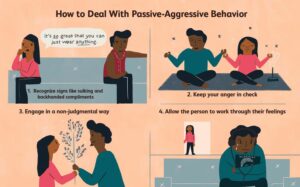Contents
- 1 What Is Passive Aggression?
- 2 Effects Of Passive Aggressive Behaviour
- 3 Types Of Behavior Under Passive Aggressive Behavior
- 4 Signs Someone Is Being Passively Aggressive
- 5 Why Do People Become Passive Aggressive?
- 6 How To Deal With Passive Aggressive Behavior?
- 7 Dealing With Passive-Aggressive Behavior Person
- 8 Ways To Help A Passively Aggressive Person
- 9 Conclusion
What Is Passive Aggression?

Passive-aggressive is a type of behavior that is exhibited when someone tries to get back at another person indirectly. This can involve things like sarcasm, procrastination, and acting cold or distant. People who use passive aggression often do so because they’re not comfortable with being direct and honest. They may feel that it’s the only way they can get what they want.
Passive aggression is, why people use it and how to deal with it. Passive aggression can be used as a coping mechanism for people who are feeling frustrated or powerless. Find out more about the causes of this type of behavior, how to identify if someone is doing it, and how you can help them by finding the underlying cause.
Passive aggression is a subconscious or conscious act of making someone angry, frustrated, or uncomfortable with the intention to later get revenge. It’s often used as a coping mechanism for people who are feeling powerless and frustrated. Learn more about what passive-aggressive behavior looks like, why people use it and how you can help them by identifying the underlying cause.
Effects Of Passive Aggressive Behaviour
Passive-aggressive behavior is a way of communicating indirectly. It’s a way of expressing anger or frustration in a way that’s indirect and usually passive. People who use passive-aggressive behavior usually do so because they’re afraid of direct confrontation or they don’t know how to express their feelings in a more assertive way.
passive-aggressive behavior can have these effects: The person using passive-aggressive behavior may feel guilt, resentment, and worthlessness. They may also feel like they’re unable to communicate what they really want. For the people around them, it can be frustrating because they never know if the passive-aggressive person is angry with them or not. This form of miscommunication often leads to arguments and broken relationships.
Difficulty To Have Healthy Relationship

Passive-aggressive behavior can be damaging to both the person who’s using it and the people around them. For the person using it, passive-aggressive behavior can lead to feelings of guilt, resentment, and worthlessness. It can also lead to problems in relationships because it’s difficult to have a healthy relationship when there’s been so much anger and resentment built up. For the people around the person using passive-aggressive behavior, it usually wears thin after a while, and the passive-aggressive person doesn’t get what they want. People don’t like feeling manipulated or controlled and eventually may cut the person using passive-aggressive behavior out of their life altogether.
Types Of Behavior Under Passive Aggressive Behavior

There are several different types of behaviors that fall under the heading ‘passive-aggressive.’ Some of the more common ones are:
- Sarcasm – Saying something that’s mean or hurtful, but in a way that makes it sound like you’re joking.
- Resentment – Feeling angry and bitter about someone or something, without ever actually talking about it.
- Silence – Withholding communication or responding in a way that’s not helpful.
- procrastination – Putting off doing something that needs to be done, usually because you don’t want to do it.
- Distant Behavior – Acting cold and uninterested, or withdrawing emotionally.
Signs Someone Is Being Passively Aggressive
Passive aggression can manifest itself in many different ways, but usually, it involves subtly trying to harm or neglect someone else. And for still others, it might be a way of deflecting attention from themselves and onto someone else. If you’re not sure if you’re dealing with passive aggression, here are some common signs:
- The person avoids eye contact or they’ll look away when you’re trying to talk to them.
- They’ll give you the silent treatment and refuse to talk to you.
- They’ll agree to do something, but then they won’t follow through.
- They constantly find ways to delay or avoid doing anything.
- They’ll make excuses for why they can’t do something.
- They always find a way to blame someone else for their mistakes.
The following are some common signs that someone is being passive-aggressive:
They Say One Thing But Do Another
 A classic example of this is when someone is asked to do something and they agree enthusiastically at the moment, but then avoid doing what they promised later on.
A classic example of this is when someone is asked to do something and they agree enthusiastically at the moment, but then avoid doing what they promised later on.
They make excuses for not getting things done or meeting expectations. For example, if you ask them to come over at 7 PM and they say “okay” but never show up. Or, if you ask them to review an important report before a certain deadline and they keep putting it off until the last minute because there’s a better time.’
They express anger indirectly
They act like everything’s fine while actually harboring resentment. This might look like pretending not to hear you when you talk, being generally uninterested in what’s going on, or rolling their eyes every time you try to communicate. This could manifest as talking behind someone’s back, purposely doing things wrong at work, or using passive-aggressive jokes.
Sarcasm is a very common form of passive-aggressive behavior. It can be tough to tell if someone is joking or not, especially if the sarcasm is directed at you. A good way to test it is to see how the person reacts when you call them out on their sarcasm. Do they get defensive? Do they laugh it off and change the subject? If so, then there’s a good chance that the sarcasm is meant to hurt.
Why Do People Become Passive Aggressive?

There are a few different reasons why people might use passive aggression. For some, it might be a way to avoid confrontation or conflict. Others may use it as a way to punish someone else. And for still others, it might be a way of deflecting attention away from themselves and onto someone else.
It Is A Coping Mechanism For Them
Typically, people who use passive-aggressive behavior do so. Because they’ve learned this kind of coping mechanism in the past. This can happen when people are punished for open anger and aggression. And thus learn that it’s easier to express what they’re feeling in an indirect way. Passive-aggressive behavior also tends to run in families: If there’s someone else in your family who uses passive-aggressive behavior you’re more likely to pick up this habit yourself.
They Can’t Communicate Complicated Feelings
Passive-aggressive behavior is often a way of communicating feelings that people are afraid to express directly. People who use passive aggression may feel insecure, helpless, or powerless when it comes to dealing with conflict. They might also feel like they’re not good enough or that their needs don’t matter. And because they fear confrontation, they’ll use passive aggression as a way to get back at the person they’re mad at without having to deal with the consequences.
They Have Anxiety Issues
People who were never properly taught effective communication skills will resort to passive-aggressive techniques in order to get their needs met. In some cases, a person might be passive-aggressive due to mental health issues including anxiety and mood disorders such as depression. However, there are also people who use passive aggression on purpose as a way of being hurtful or disrespectful. The reason people choose this form of getting back at other people rather than using direct verbal confrontation often boils down to fear of conflict and lack of assertiveness.
Passive-aggressive behavior is often destructive and can lead to major interpersonal conflicts if you do not deal with them at times. It can also be costly emotionally, leading to feelings of resentment, anger, and hostility. So how do you deal with someone who resorts to passive-aggressive tactics?
How To Deal With Passive Aggressive Behavior?
 If you’re dealing with someone who is being passive-aggressive, the first thing you need to do is try to understand what’s motivating their behavior. Once you have a better understanding of why they’re doing it, you can start to come up with ways to help them change their behavior. This might involve setting clear boundaries, communicating effectively, and/or seeking professional help.
If you’re dealing with someone who is being passive-aggressive, the first thing you need to do is try to understand what’s motivating their behavior. Once you have a better understanding of why they’re doing it, you can start to come up with ways to help them change their behavior. This might involve setting clear boundaries, communicating effectively, and/or seeking professional help.
Passive aggression can be a difficult thing to deal with. But hopefully, these tips will help you. Good luck. The use of passive aggression is often a behavior that you learn over time and is passed from one generation to the next.
This type of behavior can have a high emotional cost over time causing feelings of resentment, anger, and hostility. This can lead to major interpersonal conflicts if you do not deal with them swiftly. Passive aggression can also be a reflection of greed.
Dealing With Passive-Aggressive Behavior Person
Sometimes we get involved with people who do not know how to communicate their feelings. Whether it is disappointment or anger. To deal with such people here are some tips-
Understand Where The Person Is Coming From
If you think you’re dealing with a passive-aggressive person, the first step is to try and understand where the person is coming from. People usually use passive aggression as a way of communicating their feelings. Once you understand what’s going on, try and show empathy by validating their feelings while suppressing the hostile manner in which they communicate them. Communicate your desire to move forward with direct confrontation, honest communication, or conflict resolution.
Show Empathy
If you suspect that someone close to you is using passive aggression regularly. Try and show that person empathy by validating the feelings they may be trying to express while suppressing the hostile manner in which they do so. A great communication tip when dealing with a person who uses passive aggression is to let them know that their thinking style is clearly working for them and not against them. And encourage this communication style as it suits their needs and personality well.
Direct Confrontation

Emphasize your genuine desire to understand where they’re coming from but state your need to explore more effective options together such as direct confrontation, honest communication, or conflict resolution. It’s important that you remain firm once you’ve identified passive aggression as the issue at hand and avoid being pulled into an escalating conflict.
In some cases, seeking professional help might be the best way to deal with someone who resorts to passive-aggressive behavior. A therapist will help you understand why this person is using these tactics, how it’s affecting you and what you can do to change things for the better. With the help of a professional. You’ll learn how to set boundaries, communicate effectively and handle conflict in a healthy manner.
Ways To Help A Passively Aggressive Person
The following are some ways to help someone who is being passively aggressive:
- Listen and validate the person’s feelings.
- Be proactive about finding a solution together with the person.
- Talk to them about what they’re feeling and why they feel this way in a non-judgemental way.
- Help them get support from others, but make sure it’s not you doing all of the work for them!
- Demonstrate constant love, patience, understanding, and compassion to the person.
- Be aware that the person will likely have an outburst, so stay calm and don’t react in kind.
- Make sure you communicate effectively with the person, so they feel understood and cared for.
- Seek help from a therapist or other qualified mental health professional if needed.
The main thing that distinguishes passive aggression from assertiveness (the healthy way of expressing anger) is that the person using passive-aggressive behavior does not let you know upfront how they are feeling about something. In other words, there’s no verbal communication of their feelings. The behavior itself has this ‘passive’ quality. As in, it doesn’t seem very active or even intentional – which is why addressing as passive-aggressive behavior.
Conclusion
Passive-aggressive people may need help learning how to communicate their anger in a healthy way. If you notice someone has a pattern of passive-aggressive behavior, try not to take it personally and don’t respond in kind if they use this tactic on you. If the person knows that you’re aware of what they’re doing, they will likely feel embarrassed about their own behavior and might change it for fear of being found out. They should seek support from others who can help them learn new ways of communicating so acting out gets easier over time.
If you are looking for affordable Online Counseling MantraCare can help: Book a trial therapy session


